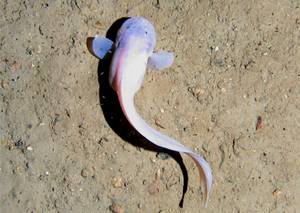Even the deepest-dwelling fish cannot survive at the lowest reaches of the ocean, and now scientists think they know why.
why.
Fish can be found flourishing at considerable depths, but they appear to be completely absent beyond 8400 metres underwater. Yet there is no obvious environmental factor, such as temperature, oxygen levels or the presence of predators, that correlates with this apparent limit of habitation, and other creatures do seem to be able to survive down there.
Now, by comparing fish living at both shallower and considerable depths, including catching the second deepest-living fish ever recorded - a snailfish recovered from over 7 kilometres down off the coast of New Zealand - an international team of scientists now suspect that biochemistry can explain why the ocean's greatest depths appear to be off-limits to even the best deep-adapted fish.
Writing in PNAS, Whitmann College, Washington, scientist Paul Yancey and his colleagues suspected that deep-sea fish might be using chemicals to stabilise their tissues against the extreme pressures at depth, which can be close to 1000 times greater than at the sea surface.
Using baited traps, fish cages and trawls to capture species in several locations, the team found that a substance called TMAO - trimethylamine N-oxide - which also give fish their characteristic smell - was present at significantly higher levels in the deep-dwellers compared with shallower-living fish.
TMAO, the team speculate, operates as a "chemical chaperone", preventing water molecules from being forced, under the extreme pressures, into the proteins within the fish tissues, which would make them buckle and denature.
With increasing depth, progressively higher concentrations of TMAO are required. The peak TMAO concentration that is biochemically possible, and beyond which the TMAO would begin to hamper rather than help protein function, would be reached at a depth of about 8200m, which is strikingly similar to the observed fish depth limit.
But what of the animals such as giant shrimp-like creatures, anemones and sea cucumbers that do exist more than 11 kilometres underwater?
The team don't know for certain, but they speculate that, unconstrained by the evolutionary legacy that fish have inherited, they have evolved an additional set of chemical chaperones that enable them to operate at these even deeper levels.
Why fish haven't also evolved these chemicals is an open question. It might be, co-author Alan Jamieson speculates, because the really deep trenches on the ocean floors have only more recently opened up, and fish haven't had sufficient time yet to evolve to enter these new realms...
- Previous Smoking versus sausages?
- Next Giant virus comes in from the cold









Comments
Add a comment